
|
From the session website: We often encounter datasets that include weak experimental phases that we must depend on in order to solve our structures. The following two datasets are examples of data collected for the purposes of solving structures by Single-wavelength Anomalous Diffraction (SAD) phasing. The anomalous signal is present, but weak, and therefore care must be taken to preserve the anomalous signal for phasing. This demonstration will educate the user on how to preserve the anomalous differences in a dataset. |
Content:
Running
% find_images
shows us two datasets of 360 images each: ACA10_AF1382_1.0001 to ACA10_AF1382_1.0360 and ACA10_AF1382_2.0001 to ACA10_AF1382_2.0360. To get some more detail, we run
% imginfo ACA10_AF1382_1.0001 ACA10_AF1382_2.0001
that gives
################# File = ACA10_AF1382_1.0001 >>> Image format detected as MARCCD ===== Header information: date = 13 Jun 2007 13:58:49 exposure time [seconds] = 4.000 distance [mm] = 125.000 wavelength [A] = 1.900000 Phi-angle (start, end) [degree] = 0.000 1.000 Oscillation-angle in Phi [degree] = 1.000 Omega-angle [degree] = 0.000 Chi-angle [degree] = 0.000 2-Theta angle [degree] = 0.000 Pixel size in X [mm] = 0.073242 Pixel size in Y [mm] = 0.073242 Number of pixels in X = 4096 Number of pixels in Y = 4096 Beam centre in X [mm] = 146.191 Beam centre in X [pixel] = 1996.000 Beam centre in Y [mm] = 148.535 Beam centre in Y [pixel] = 2028.000 Overload value = 65535 ################# File = ACA10_AF1382_2.0001 >>> Image format detected as MARCCD ===== Header information: date = 13 Jun 2007 17:52:32 exposure time [seconds] = 4.000 distance [mm] = 125.000 wavelength [A] = 1.900000 Phi-angle (start, end) [degree] = 0.000 1.000 Oscillation-angle in Phi [degree] = 1.000 Omega-angle [degree] = 0.000 Chi-angle [degree] = 0.000 2-Theta angle [degree] = 0.000 Pixel size in X [mm] = 0.073242 Pixel size in Y [mm] = 0.073242 Number of pixels in X = 4096 Number of pixels in Y = 4096 Beam centre in X [mm] = 146.191 Beam centre in X [pixel] = 1996.000 Beam centre in Y [mm] = 148.535 Beam centre in Y [pixel] = 2028.000 Overload value = 65535
So both were collected at the same wavelength, distance, osciallation angle and also starting at the same Phi angle. Maybe looking at the order the images were collected gives us some more information? With
% imgdate.sh -s * > img.lis
we get a listing of the collection time in file img.lis:
# sorted list of: file, Epoch, Date, seconds-to-previous ACA10_AF1382_1.0001 1181743129 13 Jun 2007 13:58:49 0 ... ACA10_AF1382_1.0360 1181745227 13 Jun 2007 14:33:47 5 ACA10_AF1382_2.0001 1181757152 13 Jun 2007 17:52:32 11925 ... ACA10_AF1382_2.0360 1181758981 13 Jun 2007 18:23:01 5
So unless this was a very long coffee break, the gap of more than 3 hours between the first and the second dataset probably means that the crystal was taken off the instrument and later put back. Was the second dataset collected at the same spot of the crystal or on a fresh one? Does the instrument maintain the exact same orientation of the pin on the goniostat after unmounting/remounting - or is the starting value of zero for each scan a software setting that is unrelated to the actual hardware values? Or it is a different crystal altogether? Anyway, without the exact log of the actual data collection we won't know.
| Image | Full image | Central region | Upper-left |
| ACA10_AF1382_1.0001 |  |
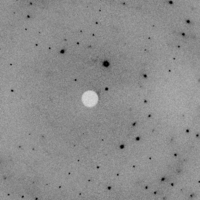 |
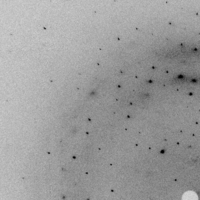 |
| ACA10_AF1382_1.0031 |  |
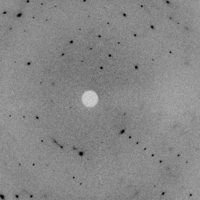 |
 |
| ACA10_AF1382_1.0061 |  |
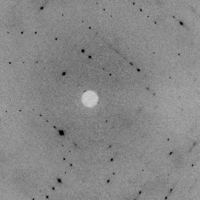 |
 |
| ACA10_AF1382_1.0091 |  |
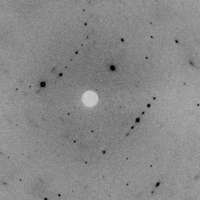 |
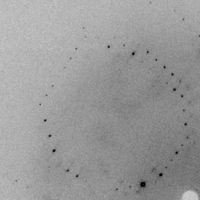 |
| ACA10_AF1382_2.0001 | 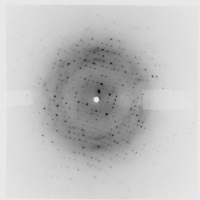 |
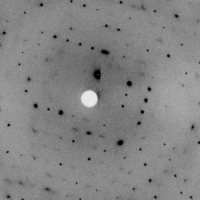 |
 |
| ACA10_AF1382_2.0031 | 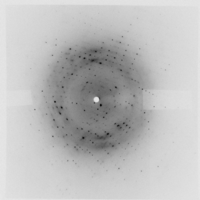 |
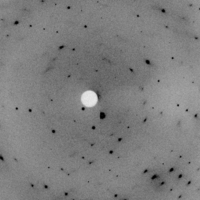 |
 |
| ACA10_AF1382_2.0061 | 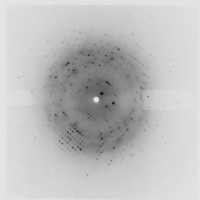 |
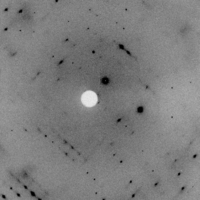 |
 |
| ACA10_AF1382_2.0091 | 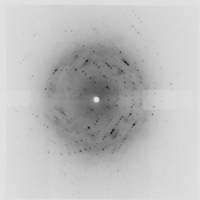 |
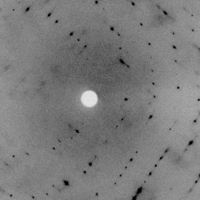 |
 |
Just running all defaults
% process -d 01 | tee 01.lis
gives
Summary data for Project: Test Crystal: A Dataset: 1.900000
Overall InnerShell OuterShell
---------------------------------------------------------------------------
Low resolution limit 19.251 19.251 2.317
High resolution limit 2.309 10.170 2.309
Rmerge 0.052 0.048 0.595
Ranom 0.051 0.046 0.574
Rmeas (within I+/I-) 0.053 0.048 0.595
Rmeas (all I+ & I-) 0.053 0.049 0.606
Rpim (within I+/I-) 0.014 0.013 0.154
Rpim (all I+ & I-) 0.010 0.011 0.112
Total number of observations 148284 1498 1554
Total number unique 5267 61 53
Mean(I)/sd(I) 55.7 71.1 9.6
Completeness 100.0 100.0 100.0
Multiplicity 28.2 24.6 29.3
Anomalous completeness 100.0 100.0 100.0
Anomalous multiplicity 14.0 10.9 14.6
and the files
Can those already be used for solving the structure? See the autoSHARP tutorial.
Work in progress